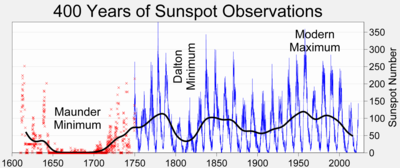|
道爾頓極小期 道爾頓極小期 (Dalton Minimum) 是大約從1790年至1830年的太陽活動低潮,是依據英國氣象學家約翰·道爾頓的名字命名的[1]。像蒙德極小期和史波勒極小期一樣,道爾頓極小期也與全球性的溫度低於平均溫度的時段相符合。例如,德國Oberlach氣象站的紀錄就有超過20年的溫度低於2.0℃[2]。低的太陽活動似乎與全球寒冷化有強烈的關聯性。 在這段時期的溫度比平均溫度要低的確實原因還不清楚。最近的論文認為火山活動的增加要為溫度降低負主要的責任[3]。 雖然無夏之年,1816年,發生在道爾敦極小期溫度最低的一年,但當年的低溫主要是因為印尼的坦博拉火山的激烈噴發,這是過去2000年坦博拉火山兩次最大的爆發之一。 註解參考資料
延伸閱讀Wilfried Schröder, N. N. Shefov在2004年發表在地質物理年報上的論文詳細分析了極光和太陽的資料。 在Wilfried Schröder, Das Phänomen des Polarlichts (The aurora in time)上也可以找到詳細的資料。 達姆斯塔特,Wissenschaftliche Buchgeselllschaft 1984,和科學編輯,不來梅,2000。
|
Index:
pl ar de en es fr it arz nl ja pt ceb sv uk vi war zh ru af ast az bg zh-min-nan bn be ca cs cy da et el eo eu fa gl ko hi hr id he ka la lv lt hu mk ms min no nn ce uz kk ro simple sk sl sr sh fi ta tt th tg azb tr ur zh-yue hy my ace als am an hyw ban bjn map-bms ba be-tarask bcl bpy bar bs br cv nv eml hif fo fy ga gd gu hak ha hsb io ig ilo ia ie os is jv kn ht ku ckb ky mrj lb lij li lmo mai mg ml zh-classical mr xmf mzn cdo mn nap new ne frr oc mhr or as pa pnb ps pms nds crh qu sa sah sco sq scn si sd szl su sw tl shn te bug vec vo wa wuu yi yo diq bat-smg zu lad kbd ang smn ab roa-rup frp arc gn av ay bh bi bo bxr cbk-zam co za dag ary se pdc dv dsb myv ext fur gv gag inh ki glk gan guw xal haw rw kbp pam csb kw km kv koi kg gom ks gcr lo lbe ltg lez nia ln jbo lg mt mi tw mwl mdf mnw nqo fj nah na nds-nl nrm nov om pi pag pap pfl pcd krc kaa ksh rm rue sm sat sc trv stq nso sn cu so srn kab roa-tara tet tpi to chr tum tk tyv udm ug vep fiu-vro vls wo xh zea ty ak bm ch ny ee ff got iu ik kl mad cr pih ami pwn pnt dz rmy rn sg st tn ss ti din chy ts kcg ve
Portal di Ensiklopedia Dunia